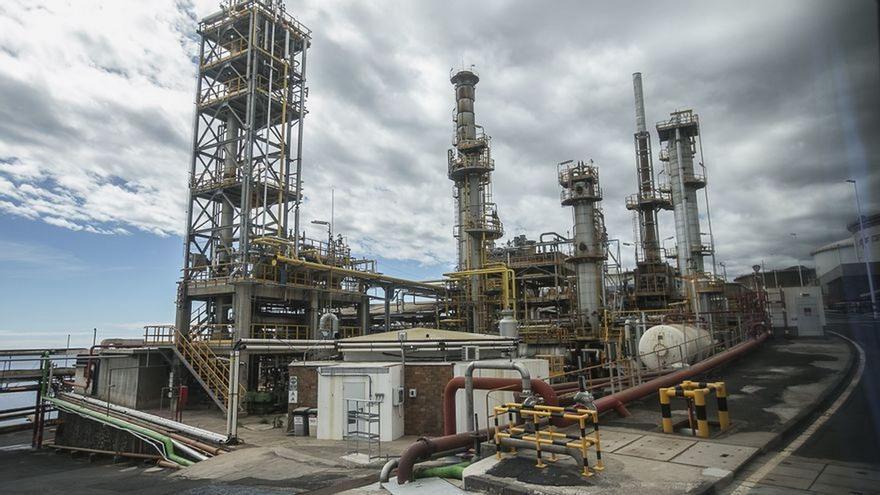
The company Cepsa will install 13 tanks in the Port of Granadilla to be able to dismantle the Refinery of Santa Cruz de Tenerife. It will build a fuel storage and distribution terminal in said port in southeastern Tenerife, which will occupy an area of more than 120,000 square meters (equivalent to about 15 soccer fields) and that it will have a storage capacity of 124,570 cubic meters (similar to the capacity of seven Olympic swimming pools).
The Canarian Government has taken to public information, for a period of 30 daysthe request from Petróleos de Canarias (Petrocan) for authorization and environmental impact assessment of this project, the execution of which will entail a investment of 84.5 million.
The new storage and distribution park for oil products, class B and C, will be located “entirely” inside the Complementary Port Use Zone of the Port of Granadilla. “Only the power line, which would leave the park towards the electrical substation located in the Granadilla Industrial Estate, would be located outside the port grounds.”
Specifically, and as Petrocan explains, the project, “whose development is essential in view of the future cessation of the activity of the Tenerife Refinery», located in the chicharrera capital, entails the construction of 11 tanks for aviation gasoline, diesel and keroseneand 2 storage tanks Marpol (variable composition waste from ships). This last service will only be provided to ships that operate with the park, “for subsequent delivery to the authorized manager of the extracted oils.”
The tanks, which will be cylindrical and vertical, will have “different volumes grouped into two retention basins, whose distribution will be such that it will comply with the provisions of the Regulation on oil installations.”
According to Petrocan, all the tanks will be equipped with the necessary elements to avoid overfilling. In addition, the gasoline tanks will have an internal floating veil to “reduce vapor emissions into the atmosphere”. With regard to possible accidental spills, the project documentation clarifies that soil contamination would not occur.
The new terminal also includes a loading dock for tankers, as well as «the auxiliary installations necessary for its correct operation», among which are the pumping system, drainage networks, hydrocarbon water treatment, pipes and transfer centers, interconnection lines to the dam, control system, electrical system, fire protection, connection electrical line, system tank purge treatment, vapor recovery unit and stormwater separator.
The adaptation of the alignment of the Exterior Breakwater of the Port of Granadilla is also contemplated, “for the purpose of receiving and supplying petroleum products, carrying out, for this, the installation of lines with the docking area for ships”. The supply of products to the storage park and the distribution of fuels will be carried out through ships that will dock at the Rivera Dock or at the Outer Dock of the Port of Granadilla. And the shipment of products will be carried out by tanker trucks, which will unload at the park’s loading/unloading area, and through pipelines to ships.
Attached buildings
The new park will also have buildings attached to the storage facilities. These are the terminal access control building; the control room; the electrical installations and communications building; the workshop and warehouse; waste storage; The laboratory; toilets, changing rooms and common areas; the rest room; the multipurpose room; the parking lot, and the pump and equipment room.
Petrocan makes it clear that in the new facility no transformation process will be performed. “The nature of all these products does not produce any change. Simply, they are received, stored, mixed and distributed, to make them reach the various points of the installation or the final consumer». The project specifies that the new park will allow fuel to be distributed to tankers and ships moored at the dock or to receive fuel from them for subsequent supply to different consumers.
Interested parties may consult the project and the environmental impact study at the office of the General Directorate of Energy, located in the Multiple Use Building I, in Santa Cruz, “by appointment”, as well as at the electronic address https://www.gobiernodecanarias.org/energia/descargas/SCyER/ConsPublica/20220408_PA202200001_PA_GRANADILLA_AA.zip.
The mayor of the capital of Tenerife, the nationalist Jose Manuel Bermudezhighlights the importance of this project, since “its execution will allow the relocation of the Refinery so that the initiative Holy Cross Green 2030, with which a new city will be created in more than half a million square meters and new services for citizens, becomes a reality». “This is one more step for the refinery to be dismantled. I am convinced that very soon we will begin to see how some units, some tanks are already disappearing », he affirms.
The Petrocan project itself indicates that the construction of the new fuel storage and distribution park in the south of the island will enable the transfer of Cepsa’s current activity in the Santa Cruz Refinery, “maintaining the logistics activity of distribution of oil derivatives on the island of Tenerife”. Also, from the new Petrocan park, which “will become the main logistics center for hydrocarbons in the Autonomous Community, diverting a very important flow of goods”, supply will be supplied to fuel consumers in the South, as well as to the rest of the Archipelago, from a location exclusively dedicated to industrial activity.
the tile
Petrocan highlights that this project It also makes it possible to put the La Tejita anchorage out of use, «refueling point to fuel the Reina Sofía Airport, thus avoiding the discharge of hydrocarbons into the open sea and, therefore, the risk of spills or leaks in the area». “With this project, the environmental and safety risks would be minimized, by reducing the distances from the point of supply to the consumers, carrying out this in safer conditions.”
















